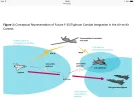Jos F-35:n ja 4:n sukupolven koneiden käyttö yhdessä kiinnostaa, Rusin Justin Bronk on julkaissut mielestäni oikein mielenkiintöisen ja analyyttisen tutkielman siitä, miten RAF:n Typhooneista ja F35:sta saadaan yhteiskäytössä paras irti.
https://rusi.org/sites/default/files/20160201_whp_maximum_value_from_the_f-35_web.pdf
Poikkeaa aika paljon linkkaamasi artikkelin lopputulemasta.
Muutama lyhyt lainaus ja lihavoimiani mielestäni hyviä pointteja:
"
the most effective use of the aircraft (F-35 huom) is likely to be as a survivable intelligence, surveillance and reconnaissance (ISR) enabler in defended airspace to enhance the lethality, flexibility and survivability of legacy platforms such as the Typhoon and the Type 45. Whilst the F-35 will have the inherent capability to perform such a role, the rest of the UK’s armed forces need to be set up to take advantage of this. If seamless interoperability is reached, the F-35 will allow these legacy assets to operate against targets and in areas which otherwise would be too heavily defended – either by providing targeting data in real time for stand-off munitions or by supressing key defensive nodes to provide a window for the main force."
"
Investments in the F-35 and the Typhoon should not be seen as a binary choice for the foreseeable future. Each aircraft offer strengths to complement the other’s particular capabilities. The combination of F-35 and Typhoon can be far more potent than a force composed entirely of either type in many operational scenarios. In this sense, the UK has an advantage amongst F-35 partner nations as it can complement the stealth strike fighter with the brute performance, reliability and load-carrying capabilities of the Typhoon."
"
The US Red Flag exercises have consistently proven that the key determining factors in air-to- air combat are situational awareness, persistence in terms of fuel and missile stores, and pilot experience. Aircraft kinematic performance is a secondary aspect that only becomes critically important in a post-merge situation – a dogfight – where opposing aircraft are in visual contact with each other and are aggressively manoeuvring to bring the other into their sights. The way the RAF’s Typhoon air-superiority fighters operate – with E-3 AWACS support and co-ordinating target information through Link 16 – is designed to ensure maximum situational awareness when approaching and operating in a given area of operations."
"Small numbers of Lightning IIs operating alongside Typhoons in a combat situation involving an opponent operating aircraft such as Russia’s Su-35S, China’s J-15 or even stealthy J-20s could enable a whole host of novel potential tactics in the air-superiority task.
With the powerful AN/ APG-81 active electronically scanned array (AESA) radar and, perhaps more crucially, the passive AN/AAQ-37 Distributed Aperture System (DAS), the F-35 is the most capable flying sensor suite yet designed for detecting modern airborne threats whilst itself remaining discreet on the electromagnetic spectrum. Coupled with its VLO or ‘stealth’ design, the F-35 can get much closer to modern aerial (and ground-based) threats than more traditional fighter platforms like the Typhoon without being engaged. In this scenario, as in others, to simply think of the F-35 as a fighter is to waste the potential of the platform. If, instead, the F-35 could covertly transfer target data to Typhoons and, potentially, take over guidance of their AMRAAM/Meteor missiles once launched, the F-35 would greatly enhance the potential lethality and survivability of the Typhoon whilst the Typhoon would provide a significant firepower advantage to the F-35. The RAF air-capability development team already sees the future of both the Typhoon and the F-35 as symbiotic assets in high-threat environments".
Katso liite: 11088
Katso liite: 11087
Ja sitten kohta jossa Bronk osuu naulan kantaan kommentoimalla vähän tätä meidänkin vääntöä:
Critics of the F-35 programme point to the aircraft’s considerable cost and the fact that compared with many competing platforms with more conventional design philosophies, the F-35 does not offer the same kinematic performance, damage resistance or payload in low-observable (‘stealthy’) configuration. The aircraft’s proponents maintain that judging the F-35 by the same criteria as previous fighter designs misses the point entirely. This paper is not intended to provide an answer to these debates.
The highly classified nature of the electronic warfare, sensor and networking capabilities at the heart of the F-35 means that any publicly available attempt to assess the pros and cons of the design as a weapons system cannot do it justice. Whilst the aerodynamic capabilities, programme difficulties and basic performance data are all in the public domain, the actual capabilities of the jet in the context in which it was designed to operate are highly classified and, therefore, can only be described in very broad terms.



 Ei sillä, että sillä olisi hirveästi merkitystä tässä ketjussa, jos ei nyt Hornet-kuski satu olemaan. Ehkäpä heitäkin on jopa joukossa... Pidätellen varmaan hymyään monessa kohtaa
Ei sillä, että sillä olisi hirveästi merkitystä tässä ketjussa, jos ei nyt Hornet-kuski satu olemaan. Ehkäpä heitäkin on jopa joukossa... Pidätellen varmaan hymyään monessa kohtaa 




